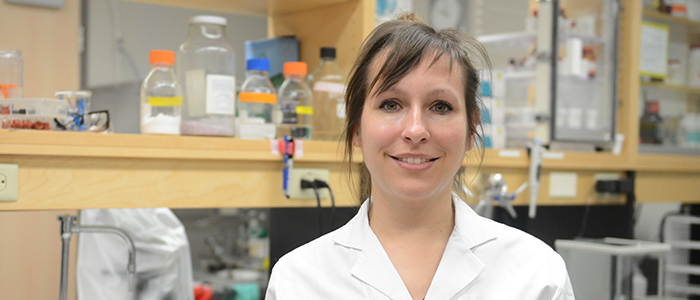The yin and yang of cannabis research

After taking on a few industrial positions in her home country of France, Justine Renard, PhD, realized the only way she could satisfy her insatiable thirst for knowledge was to continue her education in the field of neuroscience research.
Now a postdoctoral fellow in the Department of Anatomy and Cell Biology, Renard is studying the harmful and beneficial roles that cannabis can play on psychiatric diseases, such as schizophrenia. The young scientist sat down with us to discuss her transition from industry to academia, her passion for translational research, and her love of staying active outside the lab.
What is your education background?
After completing a bachelor’s degree in physiology in Lille, France, I decided to complete an industrial master’s degree in neuroscience and psychopharmacology in Bordeaux, France. I successfully completed my master’s degree in partnership with Sanofi-Aventis, a multinational pharmaceutical company in France.
What did you do once you completed your master’s degree?
The first time I worked with animal models of schizophrenia was during my work with Sanofi-Aventis, and I really enjoyed that work experience and the challenge associated with research in the industry environment. This experience confirmed and reinforced my strong interest in the neuroscience research field. After completing my master’s degree, I worked in positions with Sanofi-Aventis and Biotrial Pharmacology.
Even though these positions offered an interesting professional experience, I felt frustrated and stuck because I wanted to keep learning and be more involved with research projects, as my main interest was to understand the neurobiological mechanisms underlying normal and pathological behaviours. I realized the only way I could satisfy my insatiable thirst for knowledge was to complete my PhD in neuroscience, which I also completed in France.
What brought you to Schulich Medicine & Dentistry?
During my PhD, I studied the long-term cognitive deficits induced by chronic cannabis exposure during adolescence. When I was looking for a postdoctoral position, I wanted to complete it in a place that would give me the opportunity to practise speaking English, as French is my first language. I came across the work that Steven Laviolette, PhD, was doing with the Department of Anatomy and Cell Biology and it seemed like a great fit, even though the transition would be challenging.
Tell me about the research you are currently working on.
My current research aims to study the “yin and yang effects” of cannabis. By yin and yang, I actually mean that I am studying the controversial effects of the two major compounds of cannabis — tetrahydrocannabinol (THC) and cannabidiol (CBD) — and the harmful and beneficial roles they play on psychiatric diseases. More specifically, I am trying to understand the long-term effects of THC exposure during adolescence in the onset of schizophrenia later in life and the mechanisms underlying these harmful psychiatric effects. I am also trying to understand the antipsychotic therapeutic effects of CBD in the mesolimbic system in the brain.
I am really excited and satisfied by these research projects, because with only one plant, cannabis, I can understand mechanisms leading to psychiatric disorders, and find new therapeutics for the treatment of schizophrenia.
Through my research, I have had the opportunity to publish numerous papers, and most recently received one of The Lucille & Norton Wolf London Health Research Day Trainee Publication Awards at this year’s event.
What made you want to focus on this type of research specifically?
I have always been interested in understanding how the brain functions and how this could be altered in psychiatric disorders. I also wanted to be able to contribute to finding new therapeutics for psychiatric disorders.
It is also extremely important to me that my research has a translational impact. With the current rise in adolescent cannabis use and the increasing THC content in newer cannabis strains, it is critical that we highlight the risk factor associated with exposure to marijuana, particularly during adolescence. It is also fundamental that we find new therapeutics for schizophrenia.
What do you enjoy doing when you’re not working in the lab?
I enjoy a number of hobbies in my spare time. I love photography and staying active — I run, bike and, as a challenge, I also rock climb. I’m always try to look and go up, and never down!








